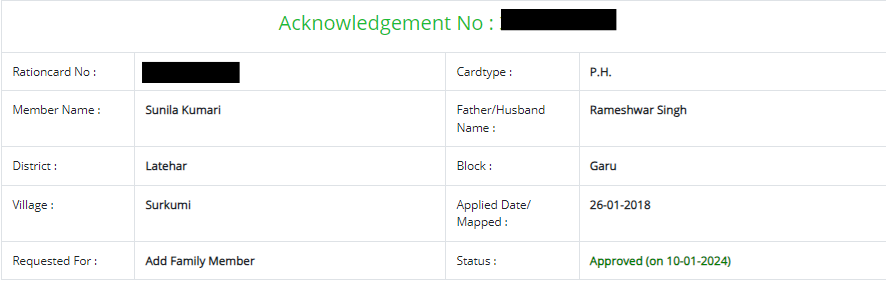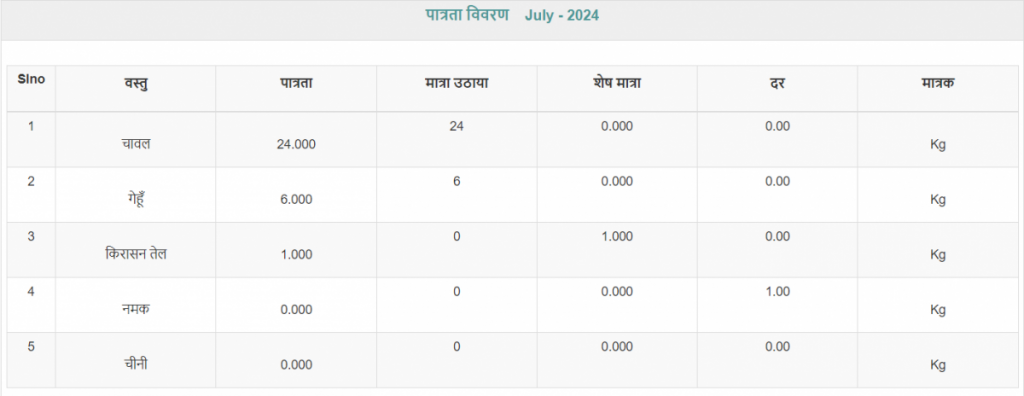Learning from Jharkhand: Advancing Transparency in Public Distribution System Portals
When we met Sunita Devi in July, she was anxious about her ration entitlements. A resident of Surkumi village in Garu, Jharkhand, receiving foodgrains through the public distribution system (PDS), she had applied years ago to add her daughter's name to her ration card but had not heard back.
The dealer claimed the name was not added because he had not received the extra foodgrains for another member of her family. However, a quick check on Jharkhand’s PDS portal revealed her daughter was indeed added at the start of the year, making seven members on the card.

Screenshots provided by authors.
Suspecting corruption, we investigated further. But the portal showed her family was only being allocated 30 kg of foodgrains – 5 kg each for six members.
While frustrating, having access to this information helped calm Sunita Devi’s worries and empowered her to hold the state accountable by raising a formal grievance.

Screenshots provided by authors.
This kind of exclusion error in a fully digitised system is not uncommon and transparency is key in bringing citizen-centric resolutions. Since its inception, the PDS has been prone to leakages and pilferages, prompting several evaluations, some notable ones being by the Planning Commission (2005) and the Justice Wadhwa Committee (2006). These reports recommended the digitisation of the PDS to increase transparency and reduce corruption.
Consequently, the digitisation of the PDS must ensure accuracy and multiple modes of resolution in case of errors or exclusions arising from digitisation. In a nutshell, it must be ensured that human-centred design and accountability are not compromised.
We believe transparency is a prerequisite of accountability, and that having the necessary technology in place, it is essential that information generated by key interactions between rights-holders and social protection programs like the PDS needs to be placed in the public domain.
Beyond the PDS, ration cards are also imperative for people to access other schemes such as the Indira Gandhi National Widow Pension Scheme, the Ayushman Bharat Pradhan Mantri Jan Arogya Yojana and several national scholarship schemes.
Governments taking steps to put information in the public domain has made public audits of schemes possible by civil society organisations and movements, which in turn strengthen the implementation of schemes by identifying their gaps.
When it comes to transparency in the PDS, the National Food Security Act, 2013 (NFSA) in its section 12(2)(b) calls for the “application of information and communication technology tools including end-to-end computerisation to ensure transparent recording of transactions at all levels, and to prevent diversion”, whereas section 12(2)(d) calls for the full transparency of records.
Further, section 27 of the Act calls for all PDS records to be placed in the public domain. Additionally, the voluntary disclosure of information is mandatory under section 4(1)(a) of the Right To Information Act. For these purposes, the Department of Public Distribution of the Union government developed a template for a web portal for the PDS.
We found different levels of commitment to transparency after exploring the PDS portals of some highly ranked states in the ‘State Ranking Index for NFSA’ such as Odisha, Uttar Pradesh and Andhra Pradesh.
Odisha being the best-performing state turned out to have the most opaque portal. Uttar Pradesh offered a little more detail and a better interface, and Andhra Pradesh offered minimal information.
Having worked with Jharkhand’s PDS portal, we realised it is more transparent than the rest and offers crucial information. Thus, we decided it was best to compare Jharkhand’s portal with that of Odisha to substantiate the need for transparency.
The two portals of Odisha are https://pdsodisha.gov.in/ (PDS Odisha) and http://www.foododisha.in/index.htm (Food Odisha). The portal of Jharkhand is https://aahar.jharkhand.gov.in/. We focus our attention on two parameters for comparing the portals – the functionality of links and data granularity.
Also read: India's Path to Food Security Has No Quick Fixes
Functionality of links
The Food Odisha website features a transparency portal under “Online Services”, but most links are either non-functional or redundant. The only accessible link under the PDS is “Current stock position”, which redirects to the supply chain management system showing district-wise data on the stock of commodities under the NFSA.
The PDS Odisha website offers various navigation options like “NFSA Cards & Beneficiaries” and “Allotment NFSA”. However, most links are inactive or non-responsive, except for the “NFSA Cards & Beneficiaries” section.
Unlike Odisha, Jharkhand’s portal does not suffer from non-functional links. While there are other minor issues that the Aahar portal faces, such as older data not being available or the delayed display of data, addressing them is beyond the scope of this article.
Granularity of data
Users in Odisha can access basic ration card information, including the number of members, their names, and entitlements, but detailed demographic information, Aadhaar seeding status and mobile number linking are absent.
This is crucial information, because Aadhaar seeding is mandatory for an individual to be able to lift rations through biometric authentication. Since the Union government has made e-KYC mandatory, this information has become more important.
Moreover, ration card details cannot be accessed using the ration card number. One has to provide district, block and fair price shop information to be able to access ration card details.
Jharkhand’s portal offers a higher granularity of data on ration cards and ration distribution. Allocation reports include the amount of allocation at the level of the dealer and the time of receiving the allocated foodgrains.
Information on ration cards includes member demographics, Aadhaar seeding status, linked mobile numbers and month-wise transactions.
Finally, details of ration distribution are available for three cards – the Priority Household, the Antyodaya Anna Yojana and Green card (the Jharkhand State Food Security Scheme).
Recommendations for a transparent portal
A transparent PDS portal can be built by working on the two parameters discussed above. All existing links must be functional and easily accessible. Once the links are fixed, information must be regularly uploaded to the portal. A range of information from different stages of the supply chain and distribution must be made public.
Direct search by ration card number should be enabled, bypassing demographic details and OTP requirements. Detailed information such as Aadhaar seeding status, mobile number linking and transaction details with timestamps should be displayed.
Dealer information, including their status and suspension details, should be made accessible, alongside allocation and distribution data with timestamps for the verification of stock movements.
Conclusion
Apart from the importance of accountability underscored in this article, the purpose of having a transparency portal is twofold.
First, making information accessible to the public invites scrutiny and constructive feedback. The quantum of data generated within the PDS across the country can not only empower citizens to claim their entitlements, but also be analysed to further strengthen the system. A comparative analysis of data from states with different levels of efficiency can highlight models that are more effective on the ground.
Second, successful grievance redressal requires greater access to information. When the rights-holders understand their rights and the design of a scheme, they are better positioned to raise grievances.
While the authors in no way insinuate anything about the efficiency of the PDS in Odisha or other states, they posit Jharkhand’s transparency portal as a template from which to learn.
The authors are associated with LibTech India.
This article went live on October twelfth, two thousand twenty four, at thirteen minutes past one in the afternoon.The Wire is now on WhatsApp. Follow our channel for sharp analysis and opinions on the latest developments.




